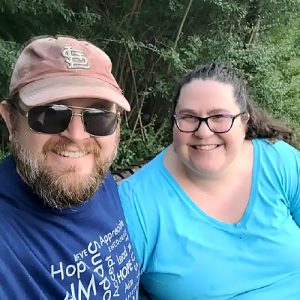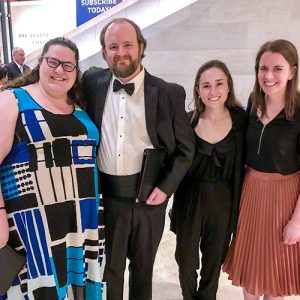 Anticipating a choir concert and project deadline at work, Silas was knocked off his feet when he experienced a stroke at age 36.
Anticipating a choir concert and project deadline at work, Silas was knocked off his feet when he experienced a stroke at age 36.
“I had a headache and was feeling a little off, but I didn’t think anything of it,” said Silas. “My wife, Kathryn, realized that something was seriously wrong after receiving a text from me that didn’t make sense.”
After seeing his text, Kathryn rushed home and found Silas sitting on the floor, struggling to speak. “When I saw the left side of his face was drooping, I knew he was having a stroke,” said Kathryn. “I knew that time is brain function with strokes, so I called 911 right away. I was probably on the phone with them 15 minutes after his stroke began. He was in surgery within two hours, which is about as fast as you can hope for in that situation.”
At the hospital, Silas’ doctor confirmed he had suffered a stroke, specifically an acute infarction of the anterior right frontal lobe involving the anterior and middle cerebral artery territories. After spending a few weeks at the hospital, Silas’ discharge planner recommended post-acute neurorehabilitation at Centre for Neuro Skills (CNS).
 When Silas arrived at CNS Dallas, he had deficiencies in the left side of his body, difficulty moving his fingers, and was a moderate fall risk. He came to CNS in a wheelchair and could only walk 10 steps before exhaustion. To address his specific needs, CNS’ physical therapists focused on getting mobilization in his left extremities through treadmill training and endurance exercises. Simultaneously, occupational therapists worked on his upper extremity fine motor skills by personalizing his program to include musical instruments, given his love for music.
When Silas arrived at CNS Dallas, he had deficiencies in the left side of his body, difficulty moving his fingers, and was a moderate fall risk. He came to CNS in a wheelchair and could only walk 10 steps before exhaustion. To address his specific needs, CNS’ physical therapists focused on getting mobilization in his left extremities through treadmill training and endurance exercises. Simultaneously, occupational therapists worked on his upper extremity fine motor skills by personalizing his program to include musical instruments, given his love for music.
After a year in CNS’ outpatient neurorehabilitation program, Silas no longer needed assistance walking distances and gained mobility and grip strength in his left hand. Silas’ therapists said he quickly returned to work because he is a highly motivated and driven person. He continues to work on strengthening his hand and uses a dictation tool to for his ongoing work as a journalist.
Kathryn is grateful for all CNS has done. “His therapists and case manager were amazing,” she said. “I met them through our monthly check-in meetings and heard about them a lot from Silas. I got to see first-hand the progress he made and still makes every day, and I know it is because of the work of the therapists as well as Silas' own work.”
Silas celebrated his neurorehabilitation journey by singing Ode to Joy with his choir. His occupational therapists Anna & Jessica were there to celebrate with he and his wife Kathryn, standing beside them as Silas moved on from CNS.
Silas is happy to be back at work, singing in his choir, and hiking with his wife.
Kathryn added that “most of our future plans now take into account that he is a stroke survivor. Nothing will change that. But, we plan with joy about what he can do, how far he has come, and how far he can still grow in every way.”
CNS Monthly Newsletter
The latest CNS updates, including events, company information, and patient care developments
The Inside View
Quarterly magazine focused on brain injury research, rehabilitation, and advancements shaping the field
Sign-up for one or both to stay connected with brain injury news and recover